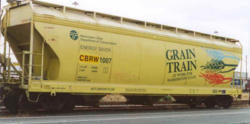Coming in hot, coming out cold?
 Grain is loaded onto a train initially coasting at the speed
v
0
m/s
by dropping it vertically from a stationary silo at the rate
α
m
kg/s
. How fast is the train moving when it exits from under the silo (in m/s)?
Grain is loaded onto a train initially coasting at the speed
v
0
m/s
by dropping it vertically from a stationary silo at the rate
α
m
kg/s
. How fast is the train moving when it exits from under the silo (in m/s)?
Details
- The train is l = 2 0 0 m long, and has an empty weight of m 0 = 5 0 0 kg.
- v 0 = 4 5 m/s
- α m = 2 0 kg/s
The answer is 37.6708.
This section requires Javascript.
You are seeing this because something didn't load right. We suggest you, (a) try
refreshing the page, (b) enabling javascript if it is disabled on your browser and,
finally, (c)
loading the
non-javascript version of this page
. We're sorry about the hassle.
2 solutions
why is there a massive difference in points between the 2 problems?
Momentum conservation gives us (for the component of momentum parallel to the velocity of the train) p ( 0 ) = p 0 = m 0 v 0 = m ( t ) v ( t ) = p ( t ) . That means v ( t ) = m ( t ) m 0 v 0 = m 0 + α m t m 0 v 0 . The second equality comes from the fact that the train gains mass in time as m ( t ) = m 0 + α m t .
To get how far the train has traveled at time T we integrate: s ( T ) = ∫ 0 T v ( t ) d t = v 0 ∫ 0 T m 0 + α m t m 0 d t = . . . = ln ( m 0 m 0 + α m T ) Now we solve the above equation for T = t l where l = s ( t l ) . That gives us t l = α m m 0 ( e v 0 m 0 α m l − 1 )
and by computing v ( t l ) we get: v ( t l ) = v 0 e − v 0 m 0 α m l = 4 5 × e 4 5 × 5 0 0 2 0 × 2 0 0 m / s ≈ 3 7 . 6 7 0 8 m / s .
plz don't overcomplicate a simple prob
Why use such an impossible scenario to ask the question? Have any of you Brilliant people seen a grain car? They are about 50 feet long and have openings for grain that are only 4 x 5 feet -it is IMPOSSIBLE to load grain in a moving train, they ALL have a solid rainproof top aka roof.-If you used real-world scenarios many would have a better chance of learning
The amount of time taken by the train to cross the silo is calculated in this problem . The expression for velocity at any time t is also calculated in the problem .
v = m 0 + α m t m 0 v 0
Using the formula for velocity and substituting the values gives v ≈ 3 7 . 6 7 1 m/s □